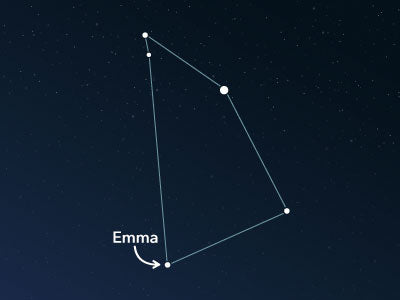The constellation Scutum
Características
- Nombre latino
- Scutum
- Hemisferio
- Hemisferio sur
- Visibilidad
- June - August
- Área
- 109 deg²
- Estrella más brillante
- α Scuti (HIP number 91117)
- Especialidades
- Open star clusters, globular clusters

The Scutum, Latin for Shield, is a small and inconspicuous constellation near the southern celestial pole. It was introduced by the Danzig astronomer Johannes Hevelius in the late 17th century. There are only a few deep-sky objects in the area.
Hemisphere, visibility, and area
The constellation Scutum can be seen in almost all inhabited places worldwide. It is fully visible in the night sky from all regions south of the equator, and it can be observed up to the 75th parallel north in the northern hemisphere. Therefore, it is visible even far beyond the northern Arctic Circle.
The best months to observe Scutum in the night sky are from June to August. It has an area of about 109 square degrees, making it the fifth smallest constellation compared to all other 88 constellations.
Scutum is depicted differently in star maps. Some representations only connect two stars with a line, while others include additional stars and connect them into an irregular quadrilateral. The brightest star in the constellation, α Scuti (Alpha Scuti), is integrated into both visualizations. It has an apparent magnitude of only roughly 3.85.
The small area and faint stars make it challenging to find Scutum in the night sky. The adjacent constellations can, therefore, provide a good orientation aid. It is bordered by the Serpens (Tail), the Aquila, and the Sagittarius, which is known from astrology.
Specialties in the constellation
The constellation Scutum lies in the band of the Milky Way, which creates several star clusters.
Among them is the open star cluster M11 (Messier 11), also known as NGC 6705. It is also called the Wild Duck Cluster. It is one of the most prominent and compact star clusters in the night sky. Its apparent magnitude is around 5.8, and its distance from earth is approximately 5,700 light-years.
It can already be observed with a pair of binoculars and be resolved into more than 400 individual stars in a medium-sized telescope. Its position is about 2° southwest of the star ß Scuti.
A globular star cluster is also located in the area of Scutum. It has the catalog number NGC 6712. Its apparent magnitude is about 8.5, and its distance from earth is estimated to be approximately 20,000 light-years. However, a larger telescope is required to observe it more closely and resolve individual stars.
History
The astronomer Johannes Hevelius from Danzig dedicated this constellation to the Polish king Jan III Sobieski. In the Battle of Vienna in 1683, the king liberated the city from Turkish besiegers and thus prevented the expansion of the Ottoman Empire in Europe. He was also a strong supporter of astronomy and always supported Johannes Hevelius in his endeavors.
The constellation is supposed to represent the shield that the king carried with him during the battle. Therefore, it was initially introduced under the name "Scutum Sobiescianum" (English: Shield of Sobieski) and later abbreviated.
PublicadoLeer más artículos interesantes

An overview of all 88 constellations
Learn more about all 88 constellations and read interesting information about the mythology, visibility, and features.

Planetario App
¡Descubre el cielo nocturno con nuestra aplicación de planetario!
Disponible para iOS y Android.

Nombrar una estrella en la constelación Shield
Name a star in a constellation and create something that lasts for eternity.